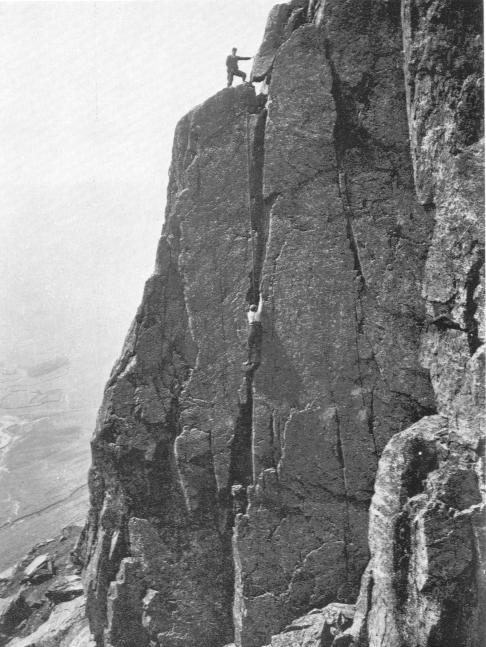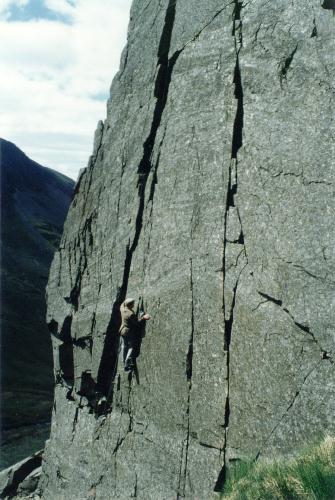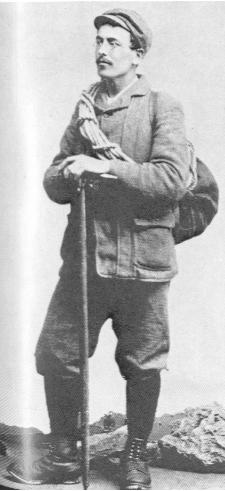One
fine morning in April I started off for Keswick aggrieved to leave Wastdale
and feeling strong after a fortnight’s scrambling. Surely if the Crack
could be done at all now would be the time, with weather and fitness
corresponding. Our party was small; two men where coming with me to look at
Kern Knotts…It was in the preceding winter that Hill had let me down from
the top of the Crack for a distance of fifty feet to a small loose platform
of rock, and I had with some extreme effort managed to return without
tugging the rope. Since that time there had been opportunity to reflect and
decide that if I could get up to the platform from below and then help
another to the same level, we could jointly manage to ascend the Crack
without further aid. If the platform could not hold two, it would be a case
of ascending the worst part of the Crack, the splayed out portion some
twelve feet high without further assistance.
On
reaching the spot things looked cheerful enough. The wall is one side of a
buttress about one hundred feet in height, and marvellously smooth to look
at. It is cut down from top to bottom by a clean edged slit passing right
through the buttress and forming on the other side Kern Knotts Chimney. At a
height of thirty feet or so is the little platform, the niche at the back of
which looks as though carved out for the reception of a piece of stationary.
The portion of the crack that leads up to this first part has a slightly
different outlook; it is more open, and is provided with holds of a shaky
description. Getting a companion to hold himself in this I mounted his
shoulders and felt about with the hands. There was nothing at all which
seemed firm. So I called for an axe, and, remembering certain tactics in an
awful rock climb in Northern Italy some years before, I rammed the axe
longitudinally into the crack and endeavoured to use it ass a hold. On this
occasion it would not act; the loose stones in the cleft were simply levered
out of place, and I had to pass the axe down again. Then ensued a few
moments fatiguing suspension from one arm with but poor foothold to ease the
strain. It was no go this time, I had to let myself down to rest awhile.
Next attempt with a little delicate balancing I reached the top hold with
both hands and dragged up to the lower step in the ledge. Thence to the
platform was an easy mater and we all began to breathe freely.
It never
occurred to me that I had made no mental note, in my previous ascent of the
crack, of the method of getting up the next part and when it came to the
test I found it impossible, three times in succession, to get my head above
a certain projecting block at the top of the niche. Each time it caught me
by the back of the neck and would not release me till in desperate extremity
I let myself down again with exhausted arms. After these failures I flung
away my coat and tied on to a rope that had been let down from above. With
renewed confidence the fourth attempt was successful. When the first twelve
feet were passed I found two wedged stones a short distance above my head.
These forced my body out of the crack altogether, but they offered
respectable holds during the process. Above these the next pitch involved a
process of backing up, though the chimney was much too narrow to brace
firmly across from side to side. I joined the men at the top after a few
more struggles, breathless and exhausted.`
After a
rest, we effected an ascent without a rope; a rapid passage of a worst bit
left me with reserve strength to climb the rest of the way comfortably.
Eighty feet and the descent by the chimney on the other side were then
disposed in seven minutes.
The first account of
a route being inspected by top rope before being climbed?

 |
Picture of Guy Newbold
doing the ascent of Kern Knotts Crack in tweeds, cloth cap and
hobnailed boots on the 100th aniversary of the first ascent 1897? and
the morning of the Team's first Kern Knotts Auction.
(please let me know the exact date
Guy) |


